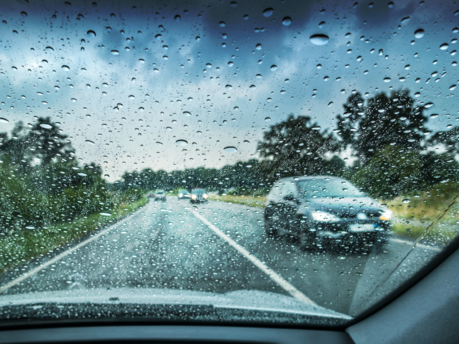How to stay safe when driving in wet weather
Discover what steps you can take to prevent accidents in the rain
UK weather is notoriously unpredictable, but there is some certainty — like rain at some point! Travelling in wet weather brings with it some extra risk, so it’s important to know what those risks are and how you can pre drive safely when it’s raining, or if it’s rained recently.
What are the risks of driving in wet conditions?
Driving in wet weather poses unique risks that demand caution. Here's a quick overview:
- Slippery roads and reduced traction can make it much easier to lose control, especially if you need to break suddenly or make any abrupt steering manoeuvres. Hydroplaning is also a major risk, where a layer of water builds up under your tyres leading to a dangerous loss of contact with the road.
- Poor visibility caused by wet weather makes it significantly harder to see road lines, pedestrians, and other vehicles sharing the road. Driving at higher speeds becomes more perilous as you may not be able to react in time to obstacles or changing conditions.
- Longer braking distances make stopping a vehicle on wet roads much more difficult to execute — requiring more time and distance compared to dry conditions.
Tips for Driving Safely in Wet Conditions
Initially, we’d encourage you to ask yourself whether your journey is necessary — if not, it might be best to delay your trip until the rain has stopped, or at least become lighter. If you need to travel in wet weather, consider the following points before setting off to give yourself the best chance of staying safe whilst driving in wet weather.
1. Do your vehicle checks
Before making any moves to drive in the rain, you need to make sure your car can handle things safely. For example, your windscreen wipers should be working correctly, with blades that aren’t split or perished so that you can clear moisture from your field of vision quickly. Ensure that your tyres are safe and legal too — the minimum legal tread depth is 1.6mm.
2. Give yourself extra time
First, leave yourself enough time to react responsibly on the roads. Falling rain, wet road surfaces and potential flooding mean that there’s a risk of seeing less, increasing your stopping distance, and pedestrians making snap decisions to cross roads to get out of the rain.
Rushing around in your car when it’s raining only heightens the risks that it poses, creating dangerous situations not only for you, but for other road users too. It’s best to plan ahead!
3. Slow down
When it’s raining, reduce your speed so that you can react to hazards in plenty of time. It takes longer to stop when the road surface is wet, and your visibility is likely to be reduced.
4. Use your lights properly
Because of that reduced visibility, others may struggle to see you if your lights aren’t on. Use your dipped headlights when the weather turns, but ensure that your main beam stays off unless it’s safe to do so - this can dazzle oncoming drivers. You shouldn’t use your fog lights without the presence of fog either!
5. Be extra careful through standing water
Aquaplaning is when a car’s tyres lose contact with the road surface, instead travelling on surface water. This happens at speed, and you’ll know that you’re aquaplaning if your steering goes light, and it becomes hard to control the car. Before going through surface water, or if you start aquaplaning, reduce your speed without braking by easing off of the accelerator.
6. Clear your windows
Rainy days can cause your windows to steam up inside, and you’ll need to be able to clear them quickly. This is where your air conditioning can come in - keep it on at a comfortable temperature, with the flow of air directed at the windscreen and the windows.
7. Increase your distance
Are you familiar with the two-second gap? This means that when the vehicle in front of you passes something stationary at the side of the road, your car should pass it at least 2 seconds later. In wet conditions, you should increase this to 4 seconds. This reduces the impact of spray from the vehicle in front, and means that you’ve got more chance of stopping clear of it in an emergency.
Get yourself a warranty
Unexpected repair costs can make a rainy day even more miserable, so protect yourself from that particular financial burden with a warranty from Warranty First. Our warranty policies provide a similar level of cover to what the manufacturer provided when the vehicle was new, so you can rest easy should anything unexpected go wrong.

